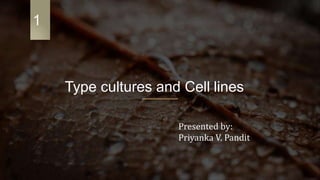
Type cultures and cell lines
- 1. Type cultures and Cell lines Presented by: Priyanka V. Pandit 1
- 2. Cell Culture – Cell culture refers to the removal of cells from an animal or plant and their subsequent growth in a favourable artificial environment. – There are three major types of cell culture, which include: i. Primary cell culture ii. Secondary cell culture, and iii. Cell line 2
- 3. Primary cell Culture – Primary cell culture refers to the stage of the culture after the cells are isolated from the tissue and proliferated under the appropriate conditions until they occupy all of the available substrate (i.e., reach confluence). – At this stage, the cells have to be subcultured (i.e., passaged) by transferring them to a new vessel with fresh growth medium to provide more room for continued growth. 3
- 4. Primary cell culture is further classified based on the type of cell: ADHERENT CELL SUSPENSION CELL 4
- 5. Adherent cells Those cell which attach to the surface of the culture flask. Forms a monolayer. They must be detached from the surface before they get sub cultured. Growth limited to surface area. Also known as anchorage cells. 5
- 6. Suspension cell Those cell does not get attached to the surface of culture flask. They are free floating. Cells in blood stream. Growth is limited to concentration of cells. Also known as anchorage independent cells. 6
- 7. Cell Lines – After the first subculture, the primary culture becomes known as a cell line or secondary cell culture or subclone. – Cell lines derived from primary cultures have a limited life span (i.e., they are finite; and as they are passaged, cells with the highest growth capacity predominate, resulting in a degree of genotypic and phenotypic uniformity in the population 7
- 8. On the basis of the life span of culture, the cell lines are categorized into two types: Finite cell lines Continuous cell lines 8
- 9. Finite cell lines –The cell lines which go through a limited number of cell division having a limited life span are known as finite cell lines. –The cells passage several times and then lose their ability to proliferate, which is a genetically determined event known as senescence. –Cell lines derived from primary cell cultures of normal cells are finite cell lines. 9
- 10. – When a finite cell line undergoes transformation and acquires the ability to divide indefinitely, it becomes a continuous cell line. – Such transformation/mutation can occur spontaneously or can be chemically or virally induced or from the establishment of cell cultures from malignant tissue. – Cell cultures prepared in this way can be sub-cultured and grown indefinitely as permanent cell lines and are immortal. Continuous cell lines 10
- 11. 11
- 13. Thank You 13